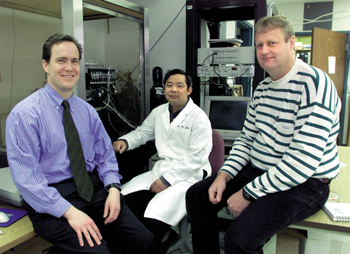
From left, Dr. Mark Anderson, Yuejin Wu, Ph.D., and Roger Colbran, Ph.D., collaborated on a paper that was published in PNAS. (photo by Dana Johnson)
Calcium’s role in heart failure focus of research
An enzyme that “translates” information about cellular calcium levels could be a molecular culprit in heart failure, according to Vanderbilt University Medical Center researchers. Their findings, published this week in the Proceedings of the National Academy of Sciences, may lead to more effective treatments for heart failure – the most common admitting diagnosis for hospitalization.
Heart failure is a problem of muscle contraction. It develops when the heart muscle weakens, for example following damage from a heart attack or chronic high blood pressure.
The Vanderbilt investigators were probing the molecular signals that accompany heart muscle contraction, especially the activity of an enzyme called CaM kinase. CaM kinase is active when there’s an abundance of calcium, which is the case during muscle cell contraction.
Because muscle cells need lots of calcium for contraction, they stockpile it inside special storage chests. When a cell gets a “squeeze now!” signal, it opens the chests, releasing enough calcium into the cell to set the contraction machinery in motion. Calcium leaves the chests through protein doors – calcium release channels (called ryanodine receptors) that were first identified by Sidney Fleischer, Ph.D., professor of Biological Sciences.
The current work shows that CaM kinase translates information between these storage chest ryanodine receptors and the calcium channels on the cell surface that control calcium entry from outside the cell.
The researchers found that CaM kinase encourages the storage chest doors to close while at the same time it prompts the cell surface calcium channels to stay open. These actions suggest that CaM kinase promotes re-filling of the depleted storage chests, said Dr. Mark E. Anderson, assistant professor of Medicine and Pharmacology.
“It’s as if the CaM kinase is saying to the (cell surface) calcium channels, ‘we just spilled a lot of calcium, and we’re going to need more to fill the stores’,” he said. “It’s really important to have a communication like this between the stores and the calcium channels – this could be the way that cells regulate the amount of calcium in the stores related to the ebb and flow in the rhythm of the heart.”
Yuejin Wu, Ph.D., research assistant professor of Medicine, used electrophysiological techniques to study calcium movements in isolated cardiac cells. To probe CaM kinase’s role in the cells, he added a special already-activated form of the enzyme provided by collaborator Roger J. Colbran, Ph.D., associate professor of Molecular Physiology and Biophysics and a recognized CaM kinase expert.
What the investigators saw, in terms of calcium movement, resembles the situation in cells from failing hearts, Anderson said. “In heart failure, if you measure the calcium coming out of intracellular stores, it looks like the situation we created by adding activated CaM kinase to normal cardiac cells – there’s muted release from the stores.”
In fact, Anderson noted, other investigators have observed elevated levels of cardiac CaM kinase activity in animal models and human beings with heart failure. The current findings suggest that abnormal CaM kinase activity in failing hearts blunts the ability of the cells to release enough “storage chest” calcium to power contraction.
Blocking CaM kinase activity with an inhibitor drug, Anderson said, “is an intriguing possibility for treating the contractile defect in heart failure.” It is a possibility the investigators will test in animal models with heart failure.
Anderson and colleagues had already published data suggesting that CaM kinase inhibitors should make effective antiarrhythmic drugs. The new findings broaden the scope of these potential medicines.
“Every treatment for heart failure that was designed to make the heart squeeze harder has failed because it causes arrhythmias,” Anderson said. “CaM kinase inhibitors could give us a two-for-one effect by reversing the contractile defect in heart failure and blocking potentially fatal arrhythmias at the same time.”
The research was supported by the National Institutes of Health and the American Heart Association Southeast Affiliate.













